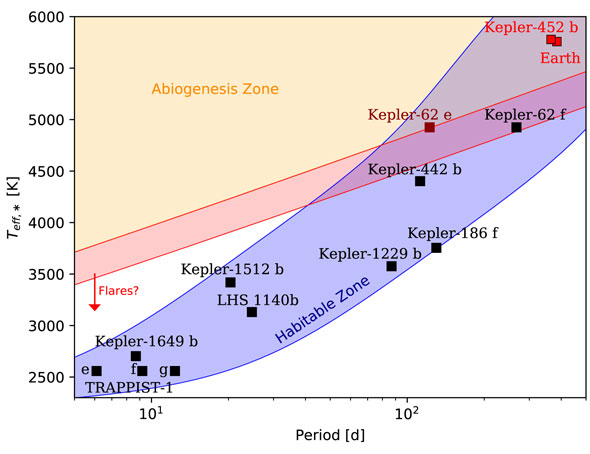Find out the latest thinking about our universe.
-
bystander
- Apathetic Retiree
- Posts: 21592
- Joined: Mon Aug 28, 2006 2:06 pm
- Location: Oklahoma
Post
by bystander » Thu Aug 02, 2018 5:15 pm
Scientists Identify Exoplanets Where Life Could Develop as It Did on Earth
University of Cambridge, UK | 2018 Aug 01
Scientists have identified a group of planets outside our solar system where the same chemical conditions that may have led to life on Earth exist.
The researchers, from the University of Cambridge and the Medical Research Council Laboratory of Molecular Biology (MRC LMB), found that the chances for life to develop on the surface of a rocky planet like Earth are connected to the type and strength of light given off by its host star.
Their study, published in the journal
Science Advances, proposes that stars which give off sufficient ultraviolet (UV) light could kick-start life on their orbiting planets in the same way it likely developed on Earth, where the UV light powers a series of chemical reactions that produce the building blocks of life.
The researchers have identified a range of planets where the UV light from their host star is sufficient to allow these chemical reactions to take place, and that lie within the habitable range where liquid water can exist on the planet’s surface. ...
The new paper is the result of an ongoing collaboration between the Cavendish Laboratory and the MRC LMB, bringing together organic chemistry and exoplanet research. It builds on the
work of Professor John Sutherland, a co-author on the current paper, who studies the chemical origin of life on Earth. ...
The Origin of RNA Precursors on Exoplanets - Paul B. Rimmer et al
Know the quiet place within your heart and touch the rainbow of possibility; be
alive to the gentle breeze of communication, and please stop being such a jerk. — Garrison Keillor
-
Bablos
- Asternaut
- Posts: 1
- Joined: Tue Nov 23, 2021 9:57 am
Post
by Bablos » Tue Nov 23, 2021 12:45 pm
It seems that such articles are published every 5 years. And all with the same content. I constantly see articles about the discovery of new planets. But that's where it ends. Expeditions are expensive and take a huge amount of time. I would like to see something so grandiose in my lifetime.
-
Hertukin
- Asternaut
- Posts: 1
- Joined: Tue Nov 23, 2021 12:46 pm
Post
by Hertukin » Tue Nov 23, 2021 12:47 pm
I hope that humanity will begin to develop new territories as soon as possible. After all, everyone knows what is happening with our planet. The news is getting worse and worse every day. I have read many times that our generation can still live its life in peace. But our great-grandchildren will get almost nothing.
-
neufer
- Vacationer at Tralfamadore
- Posts: 18805
- Joined: Mon Jan 21, 2008 1:57 pm
- Location: Alexandria, Virginia
Post
by neufer » Tue Nov 23, 2021 2:59 pm
https://en.wikipedia.org/wiki/Kepler-452 wrote:
<<Kepler-452 is a G-type main-sequence star located about 1,402 light-years away from Earth in the Cygnus constellation. Although similar in temperature to the Sun, it is 20% brighter, 3.7% more massive and 11% larger. Alongside this, the star is approximately six billion years old and possesses a high metallicity. Thus, Kepler-452 can be considered a solar twin, although it could be considered a solar analog due to its age.
The star (apparent magnitude: 13.426) hosts one confirmed exoplanet, Kepler-452b, discovered in July 2015 by the Kepler spacecraft. This planet is mostly known for its characteristics similar to Earth, most notably its size, orbit and stellar flux. It is the first potentially rocky super-Earth planet discovered orbiting within the habitable zone with an orbital period of 384.843 days. It may even have a surface temperature similar to that of Earth (the planet has an equilibrium temperature of approximately 265 K (Earth's equilibrium temperature is only 10 K cooler than this). However, its star is 6 billion years old (roughly 1.5 billion years older than the Sun). Due to this, Kepler-452b is receiving roughly 10% more stellar radiation than the Earth does today. If Kepler-452b is a rocky planet, it might be subject to a runaway greenhouse effect. However, because of its mass (estimated to be about 5 M
🜨), it may be able to prevent succumbing to the runaway greenhouse for a limited amount of time (at most about 500 million years).>>
Art Neuendorffer
